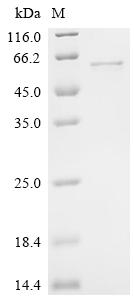Recombinant Human Z-DNA-binding protein 1 (ZBP1) is produced in E.coli and contains the complete protein sequence from amino acids 1 to 429. The protein includes an N-terminal 6xHis-tag, which makes purification and detection more straightforward. SDS-PAGE analysis confirms the product achieves purity levels above 90%, suggesting it may be well-suited for different biochemical applications. This recombinant protein is designed strictly for research purposes and appears to maintain consistent quality across experimental uses.
Z-DNA-binding protein 1 (ZBP1) recognizes Z-DNA, which forms a left-handed DNA double helix structure. The protein participates in immune response pathways, especially those that detect foreign DNA inside cells. Researchers have shown increasing interest in ZBP1 because it might help us understand how DNA triggers immune processes and could play a role in innate immune signaling networks.
Potential Applications
Note: The applications listed below are based on what we know about this protein's biological functions, published research, and experience from experts in the field. However, we haven't fully tested all of these applications ourselves yet. We'd recommend running some preliminary tests first to make sure they work for your specific research goals.
Based on the provided information, the recombinant human ZBP1 is expressed in E. coli, a prokaryotic system that is generally unsuitable for producing functional eukaryotic nucleic acid-binding proteins like ZBP1. ZBP1 is a complex protein containing multiple Z-DNA binding domains that require precise folding and specific conformational changes for its DNA/RNA recognition function. While the protein is full-length (1-429aa) with an N-terminal 6xHis tag and >90% purity, E. coli lacks the eukaryotic chaperones and post-translational modification machinery necessary for proper folding of complex nucleic acid-binding proteins. The N-terminal His-tag may interfere with the protein's DNA-binding domains. Since activity is unverified, the protein cannot be assumed to be correctly folded or bioactive without experimental validation of its Z-DNA binding capability.
1. Studying Protein Interactions Through His-Tag Pull-Down Methods
The N-terminal 6xHis tag enables technical feasibility for pull-down assays. However, if ZBP1 is misfolded (as likely in E. coli), it will not interact physiologically with true binding partners. ZBP1 requires precise conformation for specific nucleic acid and protein interactions. Identified interactions could be non-physiological artifacts. This application should not be pursued without confirmation of proper folding and DNA-binding activity.
2. Creating and Testing Antibodies
The recombinant ZBP1 can serve as an effective immunogen for generating antibodies that recognize linear epitopes, even if the protein is misfolded. The full-length sequence ensures broad epitope coverage. However, antibodies may not recognize conformational epitopes of native, properly folded ZBP1 in human cells. Validation against endogenous ZBP1 is essential.
3. Analyzing Protein Properties and Stability
This application is well-suited for assessing the recombinant human ZBP1 itself. Techniques like circular dichroism spectroscopy, analytical ultracentrifugation, and thermal shift assays can evaluate the protein's folding state and stability. These studies are valuable even if the protein is inactive, as they characterize the recombinant product.
4. Building His-Tag ELISA Systems
This application is problematic without activity verification. If ZBP1 is misfolded, ELISA assays will not accurately measure biological interactions. The assay may work for detection, but requires validation against properly folded ZBP1 for meaningful biological studies.
Final Recommendation & Action Plan
Given the high probability of misfolding in E. coli for this complex nucleic acid-binding protein, we recommend first performing comprehensive validation: 1) Functional validation using Z-DNA binding assays; 2) Biophysical characterization (circular dichroism for secondary structure, analytical ultracentrifugation for oligomeric state) to assess folding quality; 3) If possible, comparison with ZBP1 from mammalian expression systems. Antibody development can proceed immediately as the safest application. Avoid all functional studies (interactions, binding assays) until proper folding is confirmed. For reliable ZBP1 research, obtain the protein from eukaryotic expression systems capable of proper folding.






